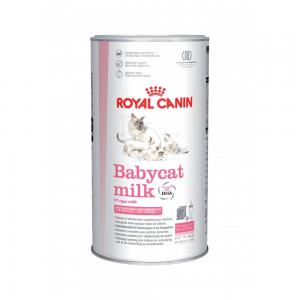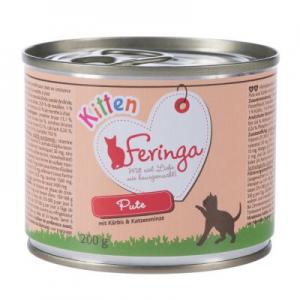What to feed your kitten at every stage of his development

What to feed kittens is a common question, and the answer is: it depends on their age.
What to feed kittens under 4 weeks old

Kittens under 4 weeks old should only ever have their mum’s milk, or kitten milk replacer (KMR) like Royal Canin Babycat milk. Do not give them Whiskas kitten milk, or any ‘kitten milk’ you can get at the supermarket - these types of milk are treats for older kittens and cats, and are not suitable for young kittens. Their digestive systems are not developed enough to be able to eat normal cat or kitten food. A word of waning: the instructions on kitten milk replacer usually suggest you mix it in a ratio that is really too strong for kittens of this age. We always dilute it more, so that it is almost the consistency of water. Do not overfeed a kitten - give them small feeds every 1-2 hours. Learn more about bottle feeding kittens
What to feed kittens 4-6 weeks old

From 4-6 weeks old kittens can be weaned onto proper food. If you have a very large litter, or the litter are not growing well, you could start this at around 3-3.5 weeks. Start this process by mixing up a quantity of kitten milk replacer, and then take a good quality, wet food and mix a little of the wet food into a saucer of kitten milk replacer. Some of the kittens will eat it straight away, others will take longer. Over a week or so, gradually increase the amount of kitten food in the milk so that you end up with just a saucer of wet kitten food. For this stage of weaning we are currently using:
-
Bozita (but be aware that it can be a bit rich and give them slightly funny tummies if you give them only Bozita) available from Zooplus
-
Feringa Menu Kitten, available from Zooplus
-
MACs cat food, available from Zooplus
However, we are always on the look out for new foods, so what we feed our kittens does change with time.
What to feed kittens 7-12 weeks old
At 7 weeks kittens should be on a high quality, wet food. There is some debate about whether special ‘kitten’ foods are much different from their normal ‘adult versions’. The general conclusion seems to be that if you are feeding just Whiskas, Felix or other supermarket foods, then you will need a kitten version. But if you are using a high quality, high meat content food like Bozita or Feringa, the adult version is probably just as good. We have not investigated this thoroughly, but we tend to use a mixture of kitten and adult foods anyway.
At this age you could start to introduce a high quality dry food or kibble if you would like to. Please do this very gradually because it can cause constipation in kittens which can be very dangerous for them if it is not resolved quickly. Before introducing any dry food at all, you must make sure that your kittens are drinking plenty of water. Read more about constipation here.
What to feed kittens 13 weeks and older
You will normally collect your kitten when she is 13 weeks old. At 13 weeks old kittens are fairly robust, and should be eating quite a lot! When you collect your kitten, keep him on exactly the same food as he is used to for about 2 weeks. Cats' immune systems are very affected by stress. Like humans, they also do not like change, so change can stress them out. Moving home is such a big change - everything sounds, smells and looks different to them. So keep everything else exactly the same to give them as much continuity as possible.
After about 2 weeks you can start to gradually move your kitten onto your food of choice, a little bit at a time. Just mix a little of the new food in with the old food each day. If your kitten eats it, you can increase the amount of new food. If your kitten is hesitant, reduce the amount of new food. Make sure you keep an eye on how much your kitten is eating. If you try to transition your kitten onto a new food too quickly, and she refuses to eat it, you need to give her the old food back. If cats or kittens lose weight very quickly, they can be at risk of hepatic lipidosis, which can be fatal, so concentrate on just making sure your kitten is eating well.
How much should I feed my kitten?
Aside from newborn, bottle-fed kittens, we never ration our kittens’ food. Kittens are very active little things, and they grow incredibly quickly. We give our kittens as much food as they want to eat, and we have never had a fat kitten! We feed our kittens 2-4 times a day, depending on their age. We simply throw away any leftovers from the previous meal, and put down fresh food for them each time. Kittens prefer their food to be fresh anyway!
If you have a Bombadillo British Shorthair kitten, we will give you an idea of how much your kitten is currently eating when you collect them. Be aware that the amount they eat will increase as they grow, so keep an eye on them to make sure you are giving them enough for their stage of life.
Some veterinary practices are not used to British Shorthairs or other large cat breeds. We have heard reports of vets weighing young cats and kittens and suggesting that they need to lose weight, even though they are within the perfectly normal range for a British Shorthair. If this happens to you, please read our article on obesity in cats so you can learn how to determine whether your cat is actually overweight, using a body scoring chart rather than the number on the scales!
Read more interesting kitten care articles...
- Read our wet cat food reviews and dry cat food reviews for more information on food choices for cats and kittens.
- Find out how to bottle feed kittens
- are you over vaccinating your cat?
- See if we have any British Shorthair kittens available at the moment